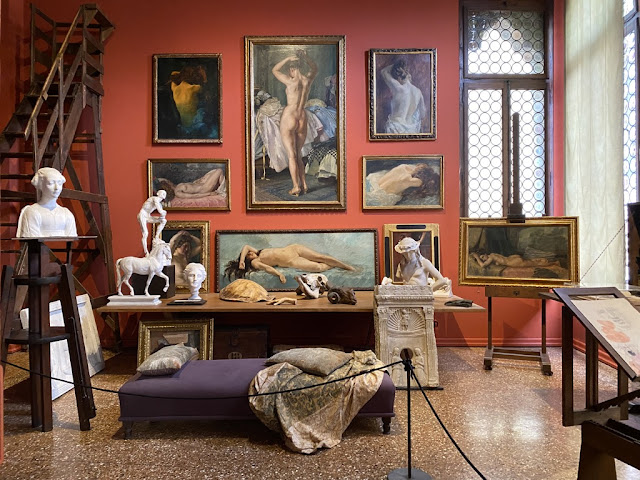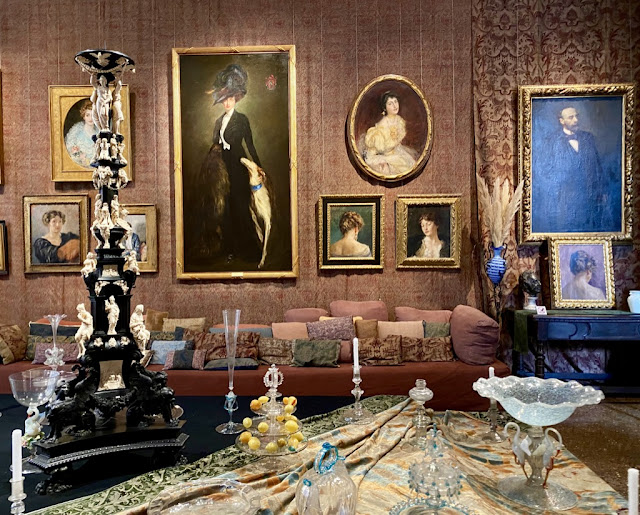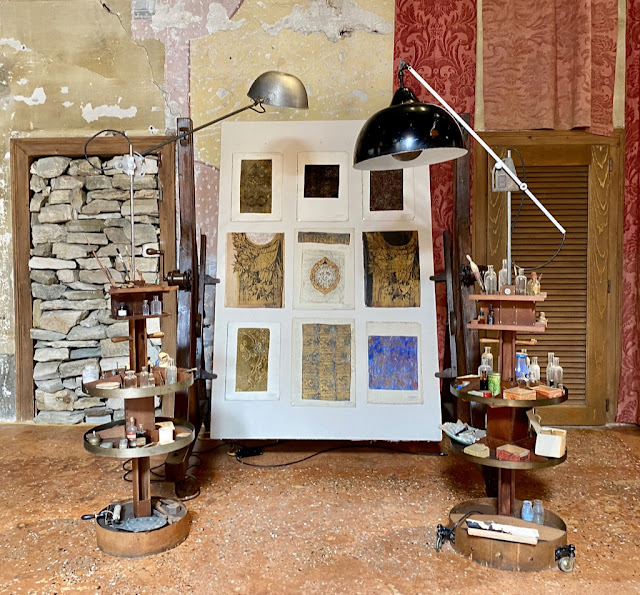Installation
view - copyright - Anselm Kiefer - photo Andrea Avezzu -
Courtesy - Gagosian
Courtesy - Fondazione Musei Civici Venezia
Palazzo Ducale - Sala dello Scrutinio
Anselm Kiefer
Questi scritti, quando
verranno bruciati, daranno finalmente un po’ di luce
Andrea Emo
Anselm Kiefer was invited by the Fondazione Musei Civici di Venezia to present
a site-specific installation of paintings that responds to one of the most important
spaces in the Palazzo Ducale - the monumental - Sala dello Scrutinio - and to the history of Venice. The exhibition, to coincide with the 59th Venice Biennale is entitled - These writings,
when burned, will finally cast a little light - Andrea Emo - until October 29 - is curated by Gabriella Belli and Janne Siren.
“It sometimes happens that there is a convergence between past and present
moments, and as they come together one experiences something of that stillness
in the hollow of a wave about to break. Originating in the past but pertaining at
bottom to something more than the past, such moments belong as much to the
present as to the past, and what they generate is of the utmost importance.”
Anselm Kiefer
Manuela Luca-Dazio and Anselm Kiefer
"Questi scritti, quando verranno bruciati, daranno finalmente un po’ di luce"
Andrea Emo
Philosophical and literary
references have always been central to an understanding of Anselm Kiefer’s
work. The exhibition takes its title - Anselm Kiefer - Questi scritti, quando
verranno bruciati, daranno finalmente un po’ di luce - loosely
translated as - these writings,
when burned, will finally cast a little light - from the writings of the
Venetian philosopher Andrea Emo - 1901-1983. Kiefer first
encountered Emo’s work six years ago and his artistic method has striking
parallels with Emo’s philosophical thought.
copyright - Anselm Kiefer - photo George
Poncet - Courtesy – Gagosian Courtesy
Fondazione Musei Civici Venezia
Anselm Kiefer’s monumental body of work represents a microcosm of collective memory, visually
encapsulating a broad range of cultural, literary, and philosophical allusions—from the Old and
New Testaments, Kabbalah mysticism, Norse mythology and Wagner’s Ring Cycle to the poetry of
Ingeborg Bachmann and Paul Celan. Born during the closing months of World War II, Kiefer reflects upon Germany’s post-war
identity and history, grappling with the national mythology of the Third Reich. Fusing art and
literature, painting and sculpture, Kiefer engages the complex events of history and the ancestral
epics of life, death, and the cosmos. His boundless repertoire of imagery is paralleled only by the
breadth of media palpable in his work.
Anselm Kiefer
Sala dello Scrutinio
Anselm Kiefer - These writings when burned, will finally cast a little light
Exhibition
The Palazzo Ducale has served as a backdrop to generations of artists including
Giovanni Bellini, Vittore Carpaccio, Titian, Veronese, Tintoretto and many
others. The monumental space of the Sala dello Scrutinio was the venue for the
elections of the Doge and its walls are richly decorated with paintings celebrating
the power of the Serenissima Repubblica di Venezia.
"As concerns the pictures, I toy with history. With Andrea Emo I have found
confirmation that history is a chain of illogical, ahistorical actions, incidents
that have nothing to do with cause and effect. Each event is a step forward
against the law of necessity. However, I toy with both historical time and
geological time. There’s the painting with the continents: that’s geological
time; see Alfred Wegener’s Continental Drift Theory. Then there’s the painting
with the uniforms: historical time, the power of the Serenissima on the terra
firma..."
Anselm Kiefer
letter to Gabriella Belli
In the installation in Palazzo Ducale Anselm Kiefer also reflects upon Venice’s
unique position between north and south and the interplay of the Orient with the
Occident. He sees equally meaningful connections between all these different
cultures and the history of Venice, where the words of Goethe’s tragic play, Faust:
The Second Part of the Tragedy - 1832 - still resonate.
co-curator - Janne Siren - director Albright-Knox Gallery
“The
mission of this great project is to understand the need for public spaces to bear
witness to our time, to construct an epiphany of our contemporary era, and to put
on stage the present and its universal values."
Gabriella Belli
Co-curator - Gabriella Belli - Director - Fondazione Musei Civici di Venezia
Mariacristina Gribaudi - President - Fondazione Musei Civici di Venezia
"The painting with the coffin containing the body of Saint Mark refers to human
time. Inside the coffin is a small sack with the relics. Even more important relics
come to mind, for example, the nails from the cross that Jesus Christ was nailed to.
Andrea Emo is certain that Christ really did die on the cross. He sees the
resurrection in the cross itself and not afterwards. For God exists in his self-
destruction. He “de-activates” himself."
Anselm Kiefer
letter to Gabriella Belli
"You’ll see: the new space I’ve created is an overlapping of all possible ideas,
philosophies from the North, from the South, from the Orient as well as from the
Occident. But there are also direct, childishly ironic interjections, for instance, the image
with the shopping carts, each of which assigned to a Doge
with a zinc name tag."
Anselm Kiefer
letter to Gabriella Belli
"...as well as the painting with the submarines: the power of Venice on the
seas. Whereby I maintain that the Venetians already had submarines."





.jpg)



































